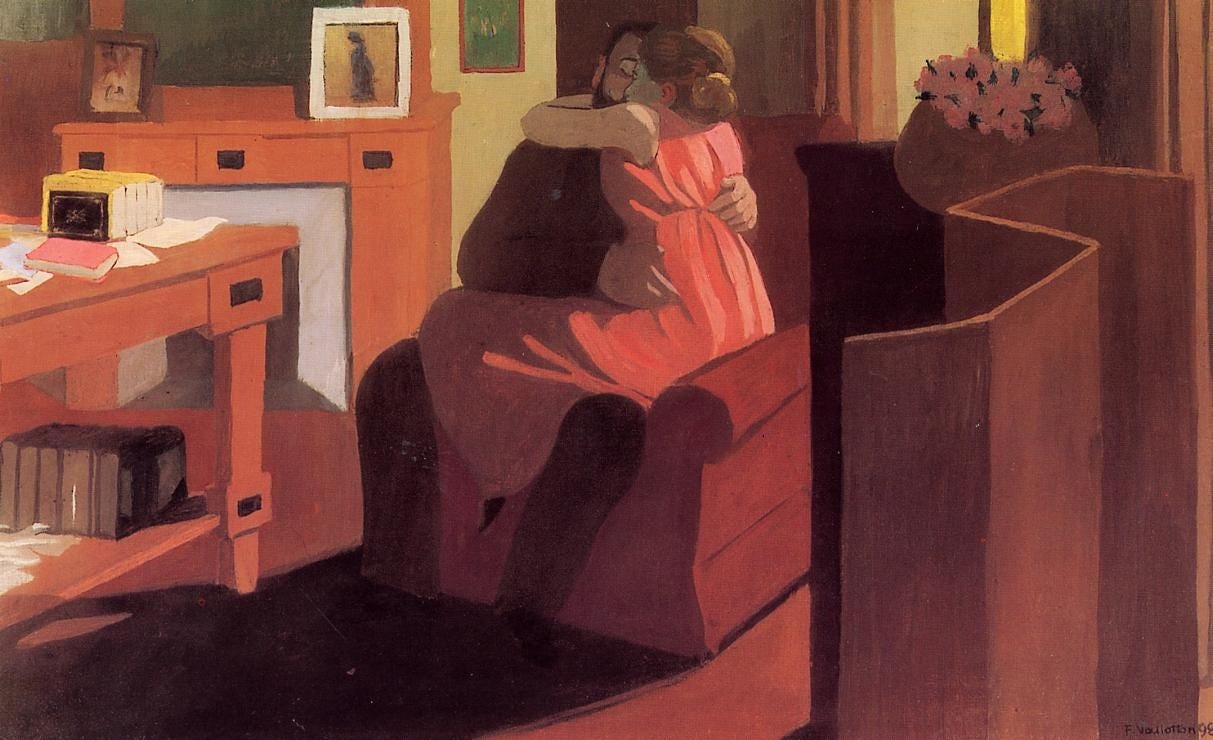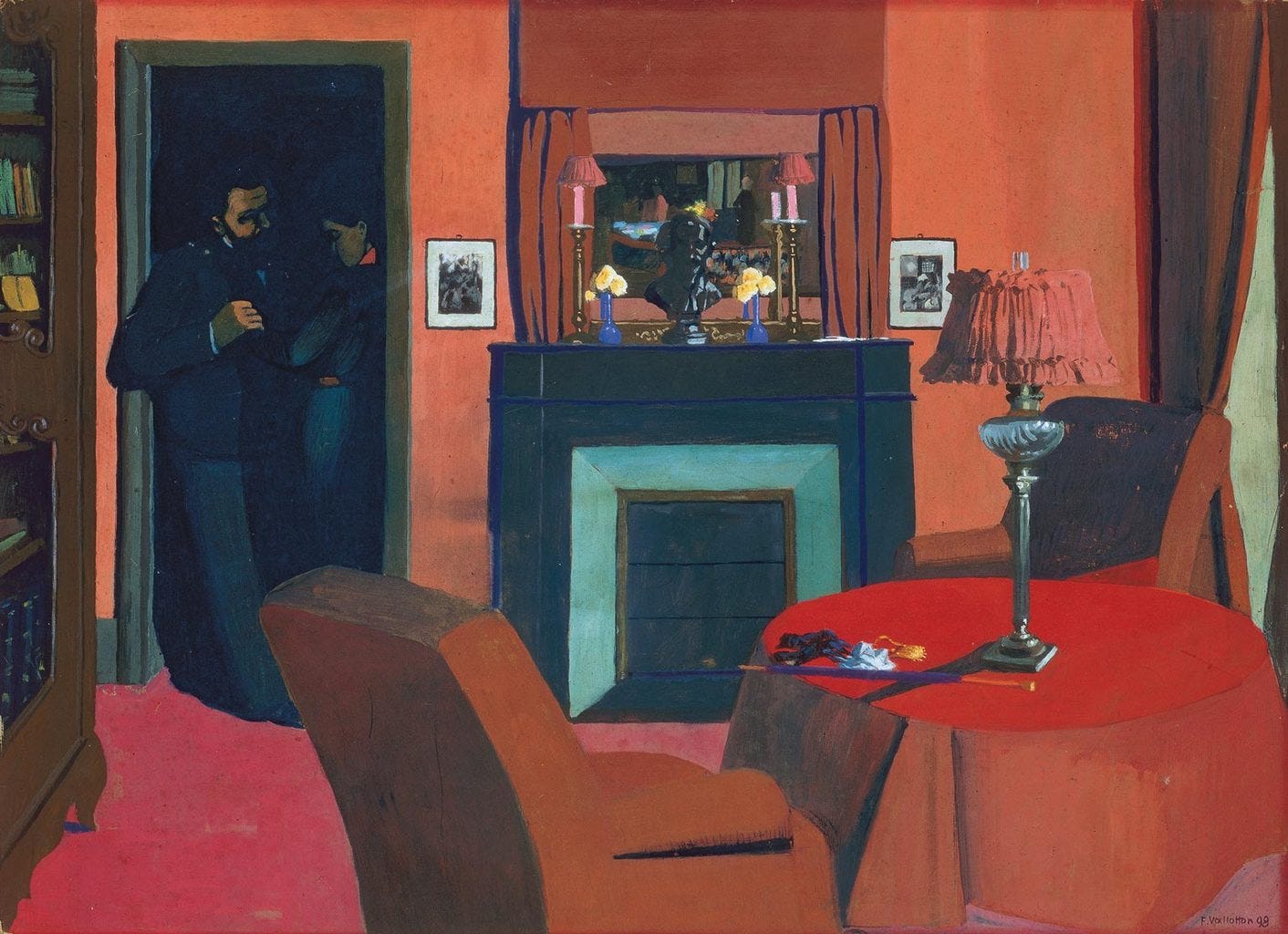Why did men and women couple up 200,000 years ago?
by Michael G. Heller
Published in Social Science Files; May 27, 2025
Interior with Couple and Screen (Intimacy) by Félix Vallotton, 1898 Switzerland
The facts are less certain the further back we go in time. Often we must rely on an assumption of a given certitude agreed upon by scholars whose reasons for certitude are open to an enormous range of more or less valid interpretations. Such is the case for the nature-given sex differentiation that becomes the initial integration in the form of the coupling of man and woman, a partnership whose evolutionary form and function is not as clear cut as one might initially suppose.
To help explain the functional coupling of man and woman I refer back to one of the baseline concepts previously introduced — ‘sociation’. Sociation is the creation of a society. From this noun can be derived the verbed sociational actions of forming and restructuring a governed society (the processes of sociation) and of sociating or becoming sociated. To build and maintain a society is to ‘sociate’.
The coupling of man and woman is not a sufficient action for the formation of a society. However, the two processes involve equivalent incentives, similarly motivated calculations, and analogous patterns of negotiation or dialogue. The widescreen long-run evolutionary view of coupling is a multi-factor journey through variation, selection, stabilisation and emulation over generations and territories. However, the mechanics of the process can be visualised as a short run individualised and purposeful ‘dickering’ over shared practicalities between a man and a woman. Experimental coupling was a proto-sociation, a model that helped pave the way for governed society. Once a society was formed, coupling could be institutionalised.
For reasons that will become apparent in the examination of the causations, the terms ‘coupling’ and ‘partnership’ are preferable to the usual alternatives. ‘Pair-bonding’ runs the risk of being confused or conflated with important sociational ‘bondings’ based on shared beliefs and identities. ‘Bond’ overrates the emotional aspects and underrates the utilitarian aspects. ‘Pairing’ is more suggestive of dancing than of dickering and ‘digging in’ for the long haul. ‘Kinship’ is too diffuse a relationship.
Though useful for understanding rulership in some later types of society, ‘kinship’ extends well beyond initial coupling motivations and is not consistently relevant to population composition or structure in early societies.1 It is also essential to dispel all the mental associations evoked in modern minds by terms such as ‘nuclear family’, ‘conjugality’ or ‘marriage’, which can be terribly misleading in the Stone Age context. We should begin with the blank slate, and not yet assume the evolution of families.
The core questions to address are — why did men and women sociate, and to what degree and by what means were they able to integrate with each other on a durable basis in spite of their sex differentiation barrier? In the absence of an irresistible reciprocal passion that overrode all practical considerations, the reasons for coupling were limited by the viabilities of individual existence in adverse environments.
There are a range of practical motivations that could have influenced individual decisions to couple-up, and which might conceivably have operated as a general evolutionary pressure for male-female partnering.
Scholars have often focused on the drive to take control of mate choices and the mating process, protections for women and children against infanticide, violence, incest, or hunger, and protections for men against their ignorance of parental lineage. Subconscious motivations could include deep language learning and acquisition of emotional intelligence, though these two evolutionary achievements might just as well have operated as indispensable precursors of sustainable intimate partnering.
None of these causes of coupling are conclusive in themselves. Rather, I think two factors were likely to have been determinant.
The first was the material utility of natural and artificial male-female divisions of labour in action domains of sex, subsistence, safety, shelter, support, and stabilisation.2
The second was the ideal utility of male-female units with exclusive possession over their own evolving discrete niches of defensible sex, subsistence, safety, shelter, support, and stabilisation. Thus ‘possession’ — forerunner of property — is a socially acceptable male-female partnership claim to a right to exclude others in the group from access to their coupled entitlements of sexual intercourse, self-foraged food, mutual protection, sleeping space, reciprocal welfare, and group representation.
The argument, then, will be that human monogamous mating choices, the sexual causes and consequences of violence, infanticide, incest, and hunger, the sexual dimensions of language learning and of emotional intelligence, and the human male’s (allegedly) evolutionary drive for paternity certainty probably all had their primal origin in a) divisions of labour and b) notions of exclusive possession.
The Red Chamber by Félix Vallotton, 1898 Switzerland
THE PLAN
I will explore male-female sex-differentiation evolutionary possibilities under the headings of ‘Polygamy’, ‘Infanticide’, ‘Incest’, ‘Possession’, and ‘Labour’. Then I will recap and integrate the five previously identified dimensions of male-leadership decision making under primitive conditions of individualistic differentiation (i.e. 1. sex, 2. age, 3. personality, 4. physique, 5. intelligence). When these blendings are done and dusted I will update and expand the explanations of the exact differences between Type 1 individualistic, Type 2 communalistic, and Type 3 coordinated societies. Then I will revise and finalise the Mesopotamian Type 4 ‘administered’ society model.
Folks, it’s up and running! The first full classification and chronology of societies.
The role of alloparenting will be touched on in the context of divisions of labour.
The reader is reminded that ‘stabilisation' refers to group decision making mechanisms that stabilise interactions in society.





